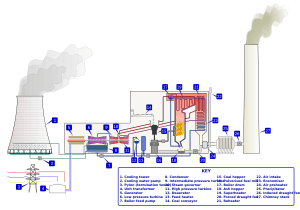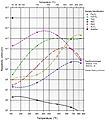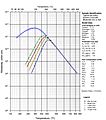Electrostatic precipitator facts for kids
An electrostatic precipitator (ESP) is a special machine that helps clean the air. It catches tiny bits of dust, smoke, and other particles from gases that are flowing through it. ESPs use a cool trick called static electricity to do this. You might find them in big power stations or factories that burn fuel to make energy. By using an ESP, these places can make sure the air they release is much cleaner and healthier for everyone.
Contents
What is an Electrostatic Precipitator?
An electrostatic precipitator, or ESP, is a device that removes tiny particles from a gas. Imagine a big vacuum cleaner for industrial smoke! It works by giving these small particles an electric charge. Then, it uses electric forces to pull them out of the gas. This helps stop air pollution.
How Does an ESP Work?
ESPs have two main parts: charging electrodes and collecting plates.
Charging the Particles
First, the dirty gas enters the ESP. Inside, there are special wires or plates called charging electrodes. These electrodes have a very high electric voltage. When the gas passes by, the electrodes create a strong electric field. This field gives a negative electric charge to the tiny dust and smoke particles in the gas. Think of it like rubbing a balloon on your hair to give it a static charge!
Collecting the Dust
After the particles get their electric charge, they move towards the collecting plates. These plates have a positive electric charge. Because opposite charges attract (like a magnet!), the negatively charged particles stick to the positively charged plates. The clean gas then continues to flow out of the ESP, while the particles stay stuck to the plates.
Removing the Collected Dust
Over time, a layer of dust builds up on the collecting plates. To remove this dust, the plates are often shaken or vibrated. This causes the dust to fall off into a special hopper or bin at the bottom of the ESP. From there, the collected dust can be safely removed and disposed of.
Why Are ESPs Important?
ESPs are very important for keeping our air clean. Many industries, like power plants that burn coal or factories that make cement, produce a lot of smoke and dust. Without ESPs, all these tiny particles would go straight into the air we breathe.
Protecting Our Health
These tiny particles can cause serious health problems, especially for our lungs. By using ESPs, industries can greatly reduce the amount of pollution they release. This helps protect people's health and makes the air cleaner for everyone.
Helping the Environment
ESPs also help protect the environment. Less pollution in the air means less smog and acid rain. It also helps keep our natural spaces, like forests and lakes, healthier.
Images for kids
See also
 In Spanish: Precipitadores electrostáticos para niños
In Spanish: Precipitadores electrostáticos para niños










